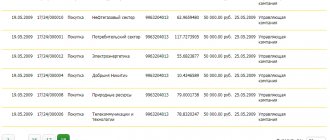What is ISIS?
Investment life insurance (ILI) is a two-in-one policy: insurance protection in case of death, disability and plus the opportunity to receive investment profit after surviving until a certain date specified in the insurance contract.
Main insurance risks:
- death from any cause;
- survival until the end of the policy term.
Additional risks:
- establishment of I, II, III disability groups as a result of the consequences of an accident;
- injuries, acute poisoning as a result of an accident;
- deadly disease.
The insured does not need to think about where to invest his savings. The insurer does this for him, forming a balanced investment portfolio with the expectation of stable profits.
The investment strategy (conservative or aggressive) is chosen by the client himself.
The choice of a particular investment product depends on the choice of strategy and set of risks. The most popular programs are designed to generate investment income for a specific purpose and create savings for your children.
Work principles
All ILI programs work according to approximately the same scheme. Only the investment strategies differ. The insurance premium received from the client is divided into a guaranteed part and an investment part.
The guaranteed part is invested in conservative financial instruments with fixed income (for example, deposits and bonds). The income received helps ensure the legally guaranteed payment amount.
The investment part is invested in highly profitable, but at the same time high-risk assets, through which significant investment income is expected. For example, in stocks. Every year the client receives a report on how much he managed to earn and where exactly his money was invested.
How to get involved?
To become a participant in the program, you need to draw up an insurance contract with the selected insurer.
To do this, you need to submit an application online on the company’s website or come directly to the office.
The client will be offered different program options depending on their willingness to risk their money.
You will also need to decide on the amount of insurance premiums, the insurance period, and the range of insurance risks.
Sums insured
The insurance amount is chosen by the client himself. This could be 1.2 million rubles or 100 thousand rubles, it all depends on the size of the budget.
For the risks of survival and death for any reason, the sum insured is 100% of the funds paid , increased by the amount of investment income.
Differences between savings and investment policies
Both policy options offer the opportunity to accumulate money by transferring premiums to the insurer. In both cases, when signing a contract for a period of 5 years or more, a social tax deduction is provided.
But only in the case of investment insurance, the client and the insurer jointly choose an investment strategy for using capital. The income from investment insurance should be an order of magnitude greater , unless, of course, there is a collapse in the financial market and a financial crisis in the country.
Advantages and disadvantages of ILI for depositors and investors
The benefits include the following:
- if the contract is concluded for a period of at least 60 months, you receive a tax deduction;
- invested funds are not recovered by court decision and are not divided between spouses in the event of divorce.
The disadvantages include:
- impossibility of terminating the contract before its expiration;
- There is no 100% guarantee of income with investment life insurance. You can get 30%, 40%, 50%, 1% or nothing at all.
Underwater rocks
Despite the tempting stories about investment life insurance, there are pitfalls. The insurer purchases call options, the movement of which cannot be predicted. Moreover, the company does not tell you what it is buying. And who will guarantee that employees generally understand how to invest correctly? That's exactly what no one is.
Investment life insurance is quickly gaining popularity in Russia. This is due to the fact that most companies still generate income for investors and quite good ones. The main thing is to choose the right insurer who will invest in serious instruments.
Decor
To obtain insurance, you need to contact your chosen insurer. You need to have your passport and money with you.
The company will prepare the text of the insurance contract in accordance with the selected insurance program and you only need to sign it.
What is stated in the contract:
- sum insured and amount of insurance premiums;
- insurance period;
- the entire range of risks that the policy covers;
- rights, obligations, responsibilities of the parties;
- payment procedure and amount of compensation depending on the type of insured event.
The contract is always signed in writing. Many companies provide the opportunity to apply online for the purchase of a life insurance policy. This reduces the processing time, because most of the data can be sent via the Internet.
As additional documents, after filling out the policyholder's questionnaire, the company may ask for medical certificates of health . For example, this is possible if the client has had serious illnesses in the past.
Profitability
Insurers make little money compared to high-risk investments in stocks or real estate. The average annual yield rarely exceeds 6-8% per annum in rubles.
However, the risks of a collapse in profitability for insurers are several times lower than, for example, for mutual funds.
Basically, companies choose balanced, conservative strategies and moderate but stable income.
When can I expect to receive payments?
Payments are made after recognition of the insurance event. This is done within the time frame specified in the contract (usually within a month). Insurers often limit the total amount of the insured amount for each risk, with the exception of an accident or plane crash.
For example, the contract states that payments cannot exceed 1.5-2 million rubles. If the client dies, the heirs will need to wait 6 months to receive the payment.
How to pay dues
Since we are talking about long-term insurance and large amounts of insurance, as a rule, payments are made at once in large amounts.
Investment insurance involves a one-time deposit of a large amount of funds, while accumulative insurance involves regular deposits of funds in smaller amounts.
Savings payments can usually be made monthly or annually. However, it is worth understanding that it is much more profitable to deposit a large amount of money annually, for example, one hundred or two hundred thousand rubles. For monthly payments, the company may impose an inconvenience surcharge; then it turns out that the policyholder will contribute more in a year than he could have contributed once during the same year.
The amount of the contribution is determined in the contract, and it cannot be changed at will without the knowledge of the insurance company.
An insured event has occurred: what to do?
If an insured event occurs, you must notify the insurer within a month. Documents for payment are also submitted in accordance with the list specified in the contract. This is done either by the insured himself or his heirs.
The following is submitted to the insurance company:
- application for insurance payment;
- copy of the passport;
- life insurance contract;
- full bank details for transferring insurance payments;
- medical certificates confirming the occurrence of disability or illness (for example, an ITU certificate establishing a disability group, etc.);
- death certificate and other documents.
If all formalities are met, the insurer pays the money to the client’s bank account. For example, for the insurance risk “Survival”, 100% of the insured amount and accrued additional investment income on the date of the insured event are paid at a time.
For the “Death” risk, in the first few years a lump sum payment is made equal to the amount of insurance premiums payable before the date of the insured event plus investment income. If the client dies from an accident or is involved in a traffic accident, then 100% of the insured amount is paid to his heirs.
The insurance company always wins
Do you know which areas of activity were, are and will be the most profitable?
- war;
- medicine;
- religion;
- crime;
- and insurance......
If we take the same ILI, what will the insurance take from us?
High commissions. According to various sources and insurance companies, the percentage received by managers when selling ILI varies from 8 to 15%. You just bought yourself a policy, deposited money, and have already cut off a decent piece from it.
Death insurance. The likelihood of an insured event is negligible. If you don’t take (don’t purposefully look for) statistics on deaths. What percentage of the insured do you think will not live to see the end of the policy? I think no more than a couple or three percent. Well, even 5%.
The insurance company promises to give (return) your money in case of death. And 2-3 times more in case of an accident. Total - a maximum of 15% will go to insurance payments. The rest remains at the disposal of the insurance company.
Free money. The participation rate allows the company not to risk its own money. And use other people’s without any responsibility for the final result. If you can make money, great. If losses are incurred, they will fall on the shoulders of the insured. Great business model.
Review of the best programs
Rosgosstrakh Life.
The company offers a range of life insurance programs. The most popular: “Caring for the future: Prestige”, “Caring for the future: Comfort for children”, “Comfort for adults”.
The insurer offers the possibility of insuring basic risks for a period of 5-15 years.
The amount of accrued additional income is not guaranteed and is determined depending on the results of the company’s investment activities.
INGOSSTRAKH-Life.
For those who are interested in investment products, the insurer offers the “Vector” program with a minimum insurance premium of 30 thousand rubles per year.
Three investment strategies are available to clients.
The first is based on the dynamics of asset growth of four investment funds, the second is investments in companies operating in the healthcare market, and the third is an investment in the Sextant Grand Large fund from the French management company Amiral Gestion. Sextant Grand Large.
The minimum investment period is 3.5 years.
SOGAZ-Life.
The company’s line of programs includes the “Trust Index” product, within which you can receive not only insurance protection in case of death or disability, but also receive investment income from investments in assets with high growth potential.
Additional financial support for loved ones is provided for clients (insurance payment of 200% of the premium in the event of the death of the insured person as a result of an accident ; payment of 300% of the premium in the event of death as a result of an accident).
RESO-Garantiya.
The company offers programs “Capital and Protection-Asset”, “Capital and Protection-Prestige”, “Capital and Protection-Maximum” and many others. The contract term is from 5 to 30 years.
The insurer is ready to accept contributions in a lump sum or in installments (once a year, six months, quarter, month). The minimum annual contribution is 3 thousand rubles, and the monthly contribution is 500 rubles.
ALPHA INSURANCE.
The insurer has investment programs: “Capital Plus”, “Forward Maximum”, “Forward Multicurrency”. The minimum insurance premium is 30 thousand rubles. The company declares an average annual return over the last 5 years at a level above 12% per annum.
Basically, money is invested in reliable bonds and shares of promising companies , including pharmaceuticals that produce drugs, medical equipment and provide medical care. The minimum contract period is 3 years.
Where is money invested under ILI agreements?
ILI may be suitable for those who are deciding on the issue of preserving their capital or family capital and savings for the future. This is an option to provide yourself with additional income for your pension in the future.
Any adult citizen of Russia or non-citizen permanently residing in the territory of the Russian Federation can invest in an ILI agreement.
To conclude an ILI agreement, it is enough to be able to make the minimum amount of insurance premium under the terms of the ILI insurance agreement.
The amount of contributions is limited to 30.0 thousand rubles. up to 5.0 million rubles, and for certain programs up to 60.0 million rubles. The amount of the actual contribution under current ILI agreements, according to experts, ranges from 500 thousand rubles. up to 2.0 million rubles, i.e. This is a product for fairly wealthy clients.
Although it is worth recognizing that investment insurance has become more accessible in the last 3 years. The amount of the minimum contribution was reduced from 300.0 thousand rubles. up to 50.0-100.0 thousand rubles, which made it possible for less wealthy clients to join the ILI program.
Nevertheless, experts advise investing in ILI if you can allocate 1-2 million rubles to this sector.
As mentioned above, insurance premiums are sent in two directions.
Most insurance premiums are used conservatively, i.e. invested in such assets that guarantee by the expiration date of the insurance contract the return and increase of most of the premium to the original amount of the insurance premium.
These are investments in low-risk assets that have a fairly low return, but guarantee their safety and return:
- deposits of large banks;
- government securities: - government short-term zero-coupon bonds (GKOs), - federal loan bonds (OFZ), - state savings loan bonds (OGSZ), - domestic state currency loan bonds (OVVZ), - treasury obligations (KO), - Bank bonds Russia (OBR).
The guarantee portion during the contract period increases to the original amount - 100%. Therefore, with a period of 3 to 5 years, low-risk instruments “slowly but surely” bring profit.
And the second (smaller) part is invested in assets that can bring both income and loss to the client. Such assets are high-risk or aggressive. In case of successful investments, the client will be able to significantly increase his capital at the expense of investment income, and if unsuccessful, he will earn nothing and receive only the initially invested funds.
High-risk assets include investments in shares of global companies, enterprises in various sectors of the world economy (innovative technologies, pharmaceutical companies, companies producing goods with high consumer properties), in precious metals (gold, platinum, silver), oil, etc.
The term of the ILI contract is 3–5 years, smoothing out various market fluctuations: with shorter terms there is a high risk of operating at a loss.
Concluding an ILI agreement requires theoretical preparation and study of the text of the agreement.
The ILI agreement must reflect the following conditions, which should be paid attention to and studied before signing:
- The procedure for distributing funds (what share goes to life insurance and what goes to investments). The longer the contract term, the larger part of the insurance premium goes into investment. The contract is concluded for a period of at least 3 years.
- The contract must indicate the coefficient of participation in the ILI. It shows the share of payments to the investor from the return on the underlying asset. It can be 100%, but is usually between 70% and 85%.
For example, if you invested money in stock market instruments with the expectation of their growth, then the calculation of the profit received is calculated using the formula:Profit = ([Start Price - Final Price] / Start Price) × Participation Rate × Amount of Invested Funds.
- Payment procedure and amount of insurance premiums. Possibility of increasing the amount of contributions. The contribution is made at a time or annually according to a schedule.
- List of insurance risks. ILI covers the main insurance risks: - survival of the policyholder until the end of the insurance contract, - death for various reasons. You can include additional risks in the contract, for example, death in a road accident or as a result of an accident. Insurance payments for these risks are established separately.
- It should be possible to change the investment strategy and its frequency.
The agreement must provide a list of strategies (directions of investment) that you can change, if necessary, once every six months or a year. You can monitor your investment in a particular asset yourself through your personal account or entrust it to an insurance company. It should be clearly understood that there is a lack of transparency in this matter.How successful an investment in a particular asset is, you can only find out from the insurance company itself. Due to competition, such information cannot be found in the public domain.
- The agreement may also provide for the fixation of investment income.
This option is included only in those insurance contracts that provide for a strategy/program with fixed income. Income fixation can be once every six months or a year. But it is beneficial to fix investment income when there is a current return on funds, and in the near future there is a forecast for its decrease.On the one hand, you ensure your future profit. On the other hand, when choosing this option, you will have to constantly “keep your finger on the pulse” so as not to lose income.
- Be sure to study the section of the contract on the terms of payments upon the occurrence of an insured event: to which persons and in what cases insurance payments are made, and which cases are not recognized as insured.
Insurance company programs/strategies:
| Insurance Company | Bank | Program/Strategy | Investment directions | Insurance period | Minimum insurance premium, rub. | Age of the insured person |
| Alfainsurance Life | Alfa Bank | Capital in plus | Global brands, High-tech IT companies | 3-5 years | From 30 thousand rubles. | 18-77 years old |
| Alfainsurance Life | Alfa Bank | Forward Maximum | High-tech IT companies | 3 years | 50 thousand rubles. – 60 million rubles. | 18-77 years old |
| Alfainsurance Life | Alfa Bank | Forward Multicurrency | Global brands, High-tech IT companies | 3 years | Up to 6 million rubles. Up to 1 million rubles. | 18-70 years 71-82 years |
| SK Ingosstrakh Life | Promsvyazbank, Binbank | Vector / Innovative pharmaceuticals | Biotechnological and pharmaceutical companies of developed countries | 3 years | Up to 6 million rubles. Up to 1 million rubles. | 18-70 years 71-82 years |
| SK Ingosstrakh Life | Promsvyazbank Binbank | Vector/Balanced Growth | Government bonds of developed countries | 3 years | Up to 6 million rubles. Up to 1 million rubles. | 18-70 years 71-82 years |
| SK Uralsib-Life | Bank Uralsib | The right decision/ Medicine of the future | Securities of leading European pharmaceutical companies (Novartis, Roche, SANOFI and others) | 3-5 years | 30 thousand rubles. — 5 million rubles. | Legally capable individual |
| The right decision / World brands | Securities of the largest companies in the US consumer market (Procter&Gamble, Gillette, Panten, Tide, Coca-Cola) | 3-5 years | 30 thousand rubles. — 5 million rubles. | Legally capable individual | ||
| The right decision/ MAX Bonds | CBKIGINF Index, calculated for a basket of the world's largest investment funds with a broad asset allocation policy | 3-5 years | 30 thousand rubles. — 5 million rubles. | Legally capable individual | ||
| Sberbank Life Insurance | Sberbank | Smartpolis | High credit quality bonds | 5-30 years | 18-70 years | |
| Shares of corporations in the innovative sector of the world economy | 5-30 years | 18-70 years | ||||
| Consumer Products Stocks | 5-30 years | 18-70 years | ||||
| VTB Life Insurance | VTB | Maximum | World Wealth / Various Asset Groups | from 3 years | from 350,000 rub. | 18-72 years |
| Fixed income | From 3 years | Not installed | From 18 years old | |||
| Balanced growth | 5 years | 600,000 rub. or 10,000 US dollars | 18-99 years old |
The ILI agreement can be terminated for various reasons:
- Expiration of the insurance period. In this case, the entire amount of insurance premiums paid and the actual investment income received (if the investment is successful) are paid.
- Early termination of the contract. A redemption amount is paid, which is reduced by the amount of penalties. Fines can reach up to 50% of the deposited funds. Some programs do not provide for payment of the ransom amount.
- Death of the insured person before the end of the contract term. The beneficiary designated by the insured during his lifetime is paid the amount of the insurance coverage. Many ILI programs provide for a double or triple payment in case of accidents or fatal accidents.
Is it worth investing money: pros and cons
Investment insurance is very beneficial in the long term.
A bank deposit does not guarantee payment in the event of sudden death or disability, but an insurance policy does the opposite.
In addition, savings transferred to the insurer are not subject to division upon divorce of spouses, and cannot be confiscated or seized until payment is made.
Benefits from investing:
- the opportunity to receive additional income;
- Survival payments are not subject to personal income tax in the amount of the contribution under the contract, increased by the average annual refinancing rate, if the policyholder and the beneficiary are close relatives;
- payments for retirement and in connection with the establishment of 1st group of disability are not subject to personal income tax;
- there is the possibility of a tax deduction in the amount of up to 15.6 thousand rubles for long-term insurance (from 5 years).
Disadvantages of life insurance:
- unfavorable conditions for terminating the contract;
- there is no clear guarantee of the amount of investment profit;
- large amounts to start with - as a rule, insurers offer programs with insurance premiums of at least 30-60 thousand rubles.
Another disadvantage of investment programs: few people know about them.
The population is already accustomed to banks and actively uses their services, but in most cases they are not at all interested in what life insurers do.
However, over the years, the population’s interest in investment products has been actively growing. For example, over the past year there has been an increase in the investment insurance market by almost 50%.
Mythical benefits
If we take a closer look at all the advantages that insurance companies emphasize, then some of the benefits received can be called into question.
Potential unlimited income. The key word is potential. No one will ever be able to say for sure (let alone guarantee) how much you will be able to earn in the future.
Managers cite various statistics from the past. That's when the clients earned 50-100% of the profit. And here they increased their investments by as much as 200% in just six months. But it is not a fact that this will happen again in the future.
In reality, you can count on the possible return as the market average - 10% per year. And taking into account the participation rate, the real profit will be reduced to 5-7% per annum.
In relation to the entire capital (savings + investment part), we can count on just a couple of percent of this “potential unlimited” annual income.
It is imperative to take into account that the average yield is indicated for long periods. On short time intervals, you can easily find yourself in a losing period and not earn a penny.
100% protection of funds. Sounds nice. Reliable. Tempting. But let's not forget about inflation. By concluding an ILI agreement, after 10 years you will receive the entire amount back, but in reality it will be 2-3 times less money at the prices in force at that time.
Insurance? You may object. What about insurance protection? All these unpleasant and not entirely profitable conditions should be compensated by the plus of free insurance protection.
What are they promising us? 100% refund of your own funds in case of death. And this is called insurance protection?
If you die from an accident, you can get 2-3 times more. A little more! But still not ice.
Don’t forget about the huge list of various exceptions, conditions and other nuances. Thanks to which the insurance company can easily refuse to pay you insurance.
Investment dynamics
If you analyze where insurers invest money, you can see that these are mainly bank deposits, government and corporate bonds, real estate and shares.
This brings a stable income of at least 5-8%, and sometimes 11-13% per annum , that is, comparable to earnings on bank deposits.
Over the past three years, market leaders have not earned more than 6-9% per annum, which is even slightly less than the return on deposits in some banks.
Investment insurance in Russia
Insurance that protects investments and finances has not received much development in Russia. At this stage, this is due to a number of circumstances.
The lack of adequate investment insurance is particularly influenced by the general situation in the country. Due to the lack of assistance and financial support from the government, companies are unable to take on major financial risks. In addition, the situation in the country does not leave room for an objective assessment of the potential danger on deposits.
Often, an obstacle to concluding contracts of this type is the lack of qualified employees capable of competently conducting each stage of the transaction.
In the Russian Federation, investors have access to only partial protection of their invested funds. An investor can protect capital invested in Russian projects by:
- creating an internal insurance reserve;
- construction site insurance;
- insurance of the purchased goods.
The situation at this stage can be changed by attracting large foreign insurance companies to the Russian market. Domestic companies must be given the opportunity to cooperate with government funds.
Are there many reviews from those who received money?
Clients generally have a positive attitude towards investment insurance. People are satisfied with insurance protection against the main group of risks, especially when it comes to borrowers or the sole breadwinners of the family.
It cannot be said that everyone is satisfied with the amount of investment income; many note that it would be possible to earn more.
As practice shows, a tiny number of insurance contracts are renewed for new terms. Mostly clients just take their money.
Among the shortcomings, large losses upon termination of the contract are also noted. If you urgently need money a year after taking out insurance, you won’t be able to get it back 100%.
According to policyholders, this is one of the main disadvantages of life insurance, especially in comparison with a bank deposit, which can be withdrawn at any time.
When choosing investment programs for life insurance, it is advisable to pay attention to the guarantee of profitability, as well as the balance of the insurer’s investment portfolio.
The main selection criterion is the reliability of the insurer itself, and secondly, the effectiveness of its investment strategy.
Where to buy an ILI policy?
Insurance companies work in close cooperation with banks. The latter are extremely interested in promoting ILI. As agents of insurers, they receive compensation to compensate for the decline in demand for some of their products. And then, the money received under agreements concluded with the help of the bank remains in it.
Numerous reviews from those who purchased insurance from a bank indicate that managers literally impose ILI without revealing many of the details and nuances of the product.
This applies to both the terms of the contract and the choice of investment strategy. Since a lot of money is invested in insurance, you should not give in to persuasion and immediately conclude an agreement. Take a time out, get to know such a complex product better on the insurance company’s website - after all, it is to them, and not to the bank, that you will entrust your money. And don't hesitate to ask questions if something is unclear to you.
Experts recommend concluding a contract at the insurer’s office, where the client can be given competent advice and helped to choose the product he needs. Bank employees often do not understand their products, but, nevertheless, impose such complex structured products, using cliched phrases in a non-core industry.











